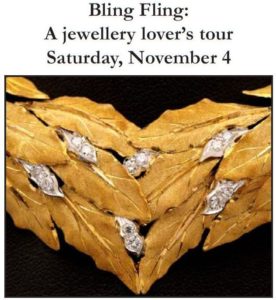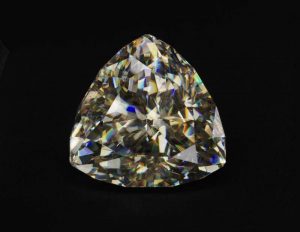
Where in Toronto can you study jewellery design? Have a custom piece made (like a wedding band) or a broken one repaired? See a world class collection of gems and minerals? Buy and sell (or just ogle) fine jewellery? Last weekend, I learned these things and more.
It was a pleasure to join the Royal Ontario Museum’s ROMBus day trip, “Bling Fling: A Jewellery Lover’s Tour” (unfortunately in place of a sick friend). Growing up with rockhound parents, I knew something about gems and minerals from a geological point of view. However, Toronto’s jewellery scene was completely new to me.
On Saturday I feasted my eyes.
The day out was one of the educational and entertaining ROMBus tours the Museum runs every year (in addition to their splendid free ROMWalks). Each outing takes you to a corner of Ontario you might not find on your own, often with subject experts. The tours are comparatively affordable and (in my experience) very well organized (thanks, ROM!).
Here’s some of what I learned on the trip.
Carole Tanenbaum Vintage Collection

The first stop was the Toronto home and studio of Carole Tanenbaum (who was unfortunately unable to join us). Carole Tanenbaum Vintage Collection is all about vintage costume jewellery. Pieces from the hand-selected collection of over 30,000 items appear in fashion magazines, and some are available for sale online and in retail shops around the world.
A gorgeous selection of costume jewellery was laid out for us to enjoy (see photo).
Eve Townsend introduced us to the high-end costume jewellery designed by the Schreiner company in the mid-twentieth-century (including the necklace in the photo at top). Eve has just published a book, “Schreiner: Masters of Twentieth-Century Costume Jewelry” featuring images of items in the Tanenbaum Collection, based on her master’s degree thesis (which I think is great – go Eve!).
OCAD University
The next stop was OCAD University (formerly Ontario College of Art and Design) to visit the studio of their Material Art & Design Program. I was impressed with Professor Robert Mitchell’s presentation on many aspects of student life, and on the jewellery design community in general. OCAD places a strong emphasis on ergonomics and health & safety to keep makers in good shape for a lifetime (yes to stretching, no to high heels in the workshop or dipping your hands in the acid bath).
As a university, OCAD concentrates on academic requirements more than fabrication, though they do teach metalsmithing, casting, computer aided design, etc. OCAD students are encouraged to take classes (like gemmology) from George Brown College’s jewellery programs, and vice versa, to round out their education.
We were told that it would cost about $5,000 to outfit a professional jewellery maker with all the necessary tools, so OCAD has a tool rental program (though students are expected to acquire their own equipment gradually). Students also purchase their own materials, though they’re not required to work in gold.
Check out this virtual tour of the studio!
And here’s an interesting economics lesson. OCAD gets jewellery making supplies from a New Mexico vendor (maybe Thunderbird Supply Company or RioGrande.com?). Why not a Canadian vendor? The U.S. vendor ships fast while a Canadian vendor must wait for a certain volume before … ordering from the New Mexico vendor anyway and adding markup. So even with taxes and duty, the U.S. vendor is still faster and cheaper.
I can almost remember that there used to be jewellery supply stores at Yonge & Queen in Toronto. We were told that, of course, rent got too expensive, so now business is mostly online.
OCAD holds a Graduate Exhibition in May, where you can see students’ work.
Royal Ontario Museum (ROM)

Probably my favourite part of the day was the visit to the ROM’s Teck Suite of Galleries: Earth’s Treasures, including the Gallery of Gems and Gold, an 800-square-foot room full of gems, crystals, and precious metals. Yes, I like earth science and the educational aspects of mineralogy … but I’m even more attracted to the beauty of a refracting jewel. You had me at bling. Anyway.
We were very lucky to meet Katherine Dunnell, Mineralogy & Geology Technician in the ROM’s Department of Natural History. Katherine told us about the history of the ROM’s collection, how coloured stones are becoming more popular in North America for engagement rings, and how you can make diamonds out of peanut butter! Also, for further education, an accessible (and blingy) book she suggests is DK Eyewitness “Rock and Gem.”
The best “take away” for me from Katherine’s talk was the idea of using gems and jewellery in historical research. She notes that by tracing provenance, you can learn who married / traded with / pillaged who(m).
There’s jewellery all through the ROM’s galleries. I’ll be back.
Made You Look
Made You Look at 1338 Queen St. W. in Parkdale is a jewellery store established in 2001 with a special purpose. Owner Sarah Hamel explained that before Etsy and other online opportunities for self-promotion existed, the collective was created to be a community for independent jewellery designers to create and sell their work.
Designers pay a monthly fee to access equipment and space in the studio, then display their work in the store. It’s an admirable business model. Clients can shop and meet the jewellery makers right there behind their work.
Here’s Sarah Hamel with more on Made You Look.
They’re also jewellery doctors at Made You Look, using the skills we learned about at OCAD (soldering, gluing, plating, etc.). In fact, Sarah told us that Made You Look offers one graduating George Brown College student a year the opportunity to join the collective, putting them “ten years ahead in their career” than their classmates.
Dupuis Fine Jewellery Auctioneers
Our last stop was Dupuis Fine Jewellery Auctioneers at 1200 Bay St., to see a preview of their upcoming auction items. Serious bling. Their auctions are held at the Windsor Arms Hotel nearby.
Feast your eyes on their Fall 2017 catalogue. The librarian in me loves that you can sort the database on a variety of metadata: by object type (ring, earrings, necklace, pendant, bracelet, brooch, suite), by designer (Birks, Bulgari, Cartier, Tiffany … all the sparkly words), by material, by carats, etc.
Their e-catalogue is especially interesting for its description of the auction process (“Lots are sold at an average pace of 90 lots per hour…,” conditions of sale, absentee bidding, etc.).
Something Vice President Duncan Parker pointed out is an ethical matter: the Auctioneers will not disclose the name of the consignor, to avoid speculation on why he or she is selling (drug problem? divorce?). Instead they will say an item is from “a Montreal collector,” or “a Southern gentleman,” or “a lady of royal title,” as a descriptive alternative to “Lot 42.”
It was a very good day. Thanks again to ROMBus and the Royal Ontario Museum volunteers!
If you found this post interesting, feel free to share it.

